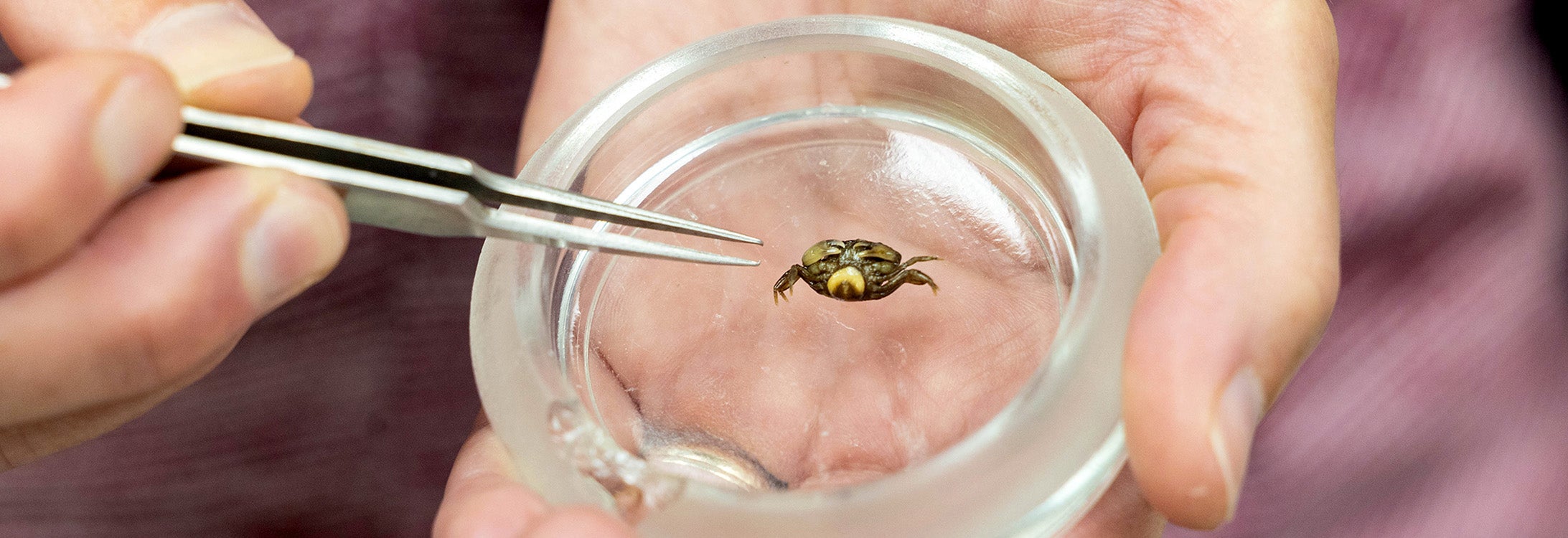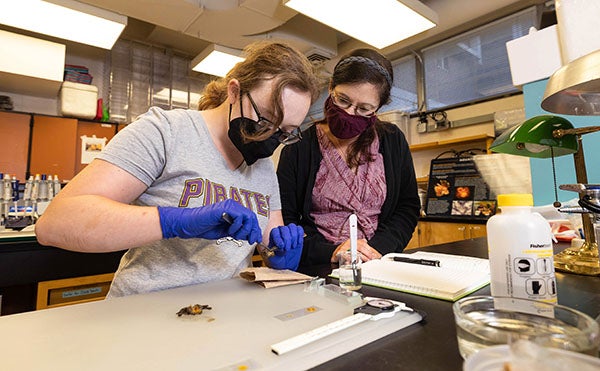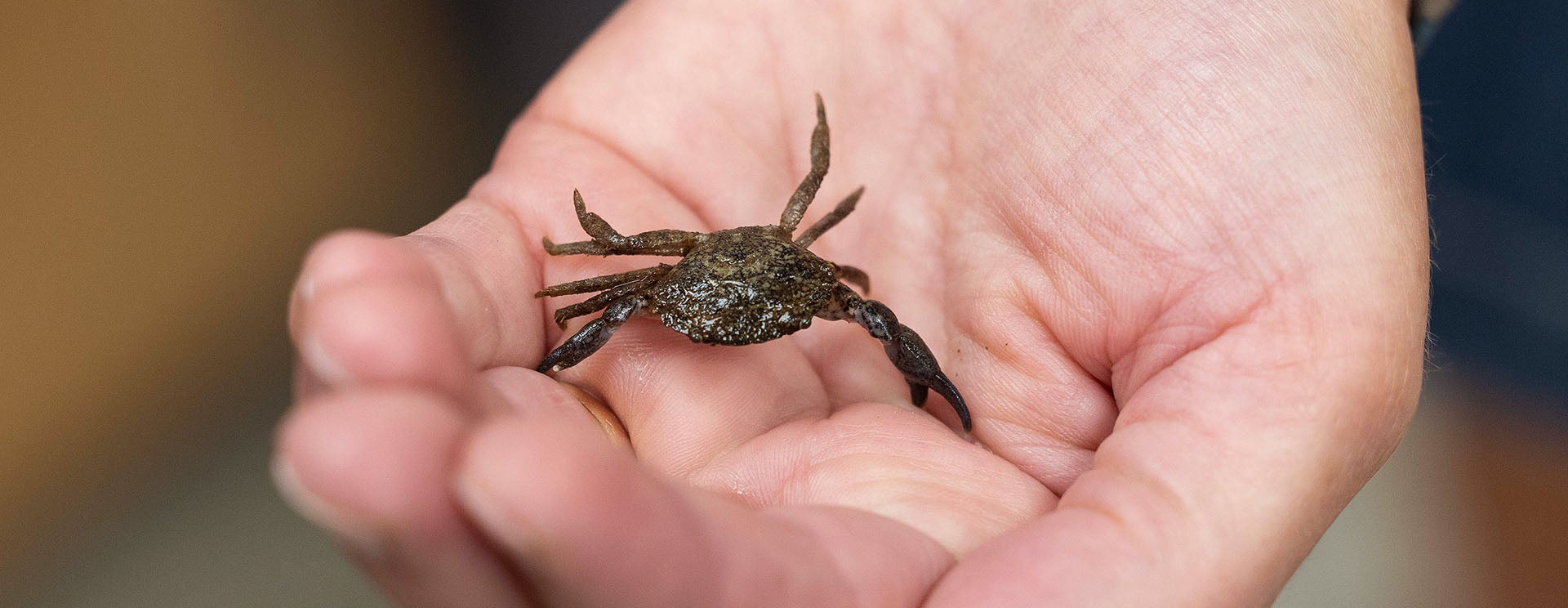
[ad_1]
Parasite hijacks reproduction and behavior of mud crabs
As each day and night brings us closer to Halloween, a veritable invasion of body thieves takes place in the Pamlico and Neuse rivers.
Since 2016, a team of researchers led by Dr April Blakeslee of East Carolina University Biology department monitored mud crab populations in both rivers to study the prevalence and impact of a parasitic barnacle native to the Gulf of Mexico. The results were published this summer in the Proceedings of the Royal Society B, a journal of biological research.
The parasite, called Loxothylacus panopaei or Loxo for short, is very damaging to its mud crab hosts, castrating them and replacing the crab’s reproductive system with its own. A series of roots extend into all of the crab’s tissues, including its nerve center, Blakeslee said. Crabs can no longer reproduce but continue to live and feed, in some cases even protecting the spawning of the parasite like theirs.
The parasite’s takeover over the bodies and behavior of the living crabs has led the team, which includes several graduate and undergraduate students, to dub the infected creatures “zombie crabs.”
The research team studied the effects of salinity on crabs and the parasite, monitoring populations using crab condos – plastic crates filled with oyster shells to create natural habitat – in six sites on the Pamlico and five on the Neuse. They found that the parasite is less prevalent as the salinity decreases, either moving upstream or during a flood such as a tropical storm or hurricane.
“We’ve seen that basically at less than 10 parts per thousand, the parasite just doesn’t exist,” Blakeslee said.

Department of Biology assistant professor April Blakeslee, right, watches graduate student Haley Hagemeier examine a mud crab.
Unfortunately, the low salinity is also less suitable for crabs.
“They’ve evolved to have a range of salinities that they can survive and they tend to do a lot better when they’re in more moderate salinities,” she said. “We used time-to-right response testing; you put a crab on its back and time the time it takes for it to turn around. This gives you an indication of stress because [if they’re] healthy and happy they will turn around very quickly because it is a very vulnerable position, but if they are stressed in any way they will take longer.
In the moderate salinities that crabs prefer, the parasite can spread quickly throughout the population. The team found infection rates at some sites as high as 80%.
Since the parasite is an invasive species in Atlantic waters, likely arriving in Chesapeake Bay with transplanted oysters in the 1960s, the crabs here have not evolved to deal with it, Blakeslee said, and “they can really get hammered by this parasite.” In the Gulf of Mexico, where mud crabs have developed some resistance, infection rates are much lower, in the order of 5%.
The high infection rates negatively impact the crab population since the parasite prevents them from reproducing, and there is a higher rate of predation by large crab predators. That impact could ripple up and down the food chain, as mud crabs are prey for things like blue crabs, fish and birds, Blakeslee said.
Research is also important because there is a similar species of parasite that is also found in the Gulf of Mexico that can infect blue crabs, a commercially important (and delicious) species.
“We have now seen how quickly this parasite can spread … so we hope that our research can help us understand what could happen if we do not try to prevent these invasions from happening,” she said. declared.
Going forward, Blakeslee and his students will continue to monitor mud crab populations at fewer sites and with less frequency.
“It will be useful to continue looking at it through time as it is an evolving story, as this parasite has only been in the region for a few decades. So changes in this ecosystem are still ongoing, ”said Blakeslee. The team is also testing for genetic differences to see if crabs evolve to tolerate lower salinities to avoid the parasite, or if the parasite can evolve to follow its hosts.
ECU students Chris Moore, Timothy Lee, Rebecca Barnard, Kyle Swanson, Laura Lukas and Matthew Ruocchio are the co-authors of the publication.
“They learn from the field research, they learn how to use the equipment that we use there, and they learned a lot about invasive species and just being able to identify organisms in the field,” said Blakeslee. “We get a lot of other organisms [in the condos] also, so they learned a lot about taxonomic diversity, different kinds of little creatures.
The North Carolina Estuary in Washington, which serves as a sampling site, also partnered with the Blakeslee team and ECU’s Kayla Clark School of Art and Design to develop an invasive species exhibit featuring zombie crabs, which opened in 2017.

A healthy mud crab.
Related:
Seashell thieves
Zombie crabs
MORE STORIES
[ad_2]
Source link